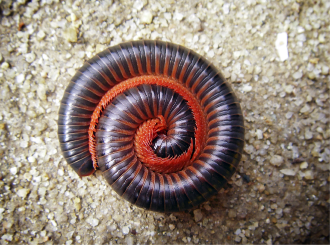Diplopoda: Difference between revisions
Jump to navigation
Jump to search
m Picture 2 |
mNo edit summary |
||
| Line 33: | Line 33: | ||
== Reproduction and Life Cycle == | == Reproduction and Life Cycle == | ||
[[File:Gonopods.png|351px|left|thumb|Gonopods of the millipede species ''Sigmocheir furcata''<ref name="Gonopods">Marek, P. ''et al.'' A species catalog the millipede family Xystodesmidae (Diplopoda: Polydesmida). Virginia Museum of Natural History. https://www.researchgate.net/publication/267810849_A_species_catalog_the_millipede_family_Xystodesmidae_Diplopoda_Polydesmida</ref>]] | [[File:Gonopods.png|351px|left|thumb|Gonopods of the millipede species ''Sigmocheir furcata''<ref name="Gonopods">Marek, P. ''et al.'' (2014). A species catalog the millipede family Xystodesmidae (Diplopoda: Polydesmida). Virginia Museum of Natural History. https://www.researchgate.net/publication/267810849_A_species_catalog_the_millipede_family_Xystodesmidae_Diplopoda_Polydesmida</ref>]] | ||
== Diet and Feeding Behaviors == | == Diet and Feeding Behaviors == | ||
== Distribution == | == Distribution == | ||
Revision as of 08:40, 3 April 2025
 | |
| Kingdom: | Animalia |
|---|---|
| Subkingdom: | Bilateria |
| Infrakingdom: | Protostomia |
| Superphylum: | Ecdysozoa |
| Phylum: | Arthropoda |
| Subphylum: | Myriapoda |
| Class: | Diplopoda |
Diplopods, more commonly known as millipedes, are long, segmented invertebrates belonging to the subphylum Myriapoda. The Latin meaning of the name Diplopoda, 'having double feet', refers to the distinctive features of millipedes, in which they possess two pairs of legs per body segment [2][3]. While their common name means 'thousand feet', most millipede species possess 47 to 197 pairs of legs[4]. However, in 2020, the first millipede species with over one thousand legs was discovered in Western Australia — Eumillipes persephone, with 1,306 legs[5].
Characteristics and Morphology
Reproduction and Life Cycle
Diet and Feeding Behaviors
Distribution
- ↑ Integrated Taxonomic Information System (ITIS). n.d. Diplopoda. https://itis.gov/servlet/SingleRpt/SingleRpt?search_topic=TSN&search_value=154409#null
- ↑ Merriam-Webster. n.d. Diplopoda. https://www.merriam-webster.com/dictionary/Diplopoda
- ↑ Hennen, D. & Brown, J. n.d. Millipedes of Ohio Field Guide. Ohio Division of Wildlife. chrome-extension://efaidnbmnnnibpcajpcglclefindmkaj/https://dam.assets.ohio.gov/image/upload/ohiodnr.gov/documents/wildlife/backyard-wildlife/Millipedes%20of%20Ohio%20Pub%205527.pdf
- ↑ Tohono Chul. n.d. Millipede Facts. chrome-extension://efaidnbmnnnibpcajpcglclefindmkaj/https://tohonochul.org/wp-content/uploads/2020/07/Millipede_Facts_Worksheet.pdf
- ↑ Marek, P., et al. (2021). The first true millipede—1306 legs long. Scientific Reports. https://www.nature.com/articles/s41598-021-02447-0
- ↑ Marek, P. et al. (2014). A species catalog the millipede family Xystodesmidae (Diplopoda: Polydesmida). Virginia Museum of Natural History. https://www.researchgate.net/publication/267810849_A_species_catalog_the_millipede_family_Xystodesmidae_Diplopoda_Polydesmida